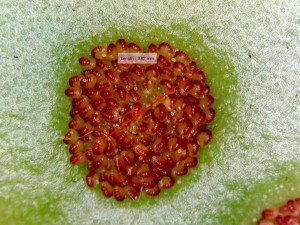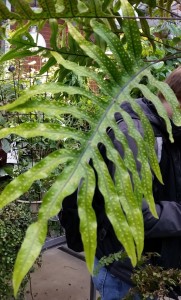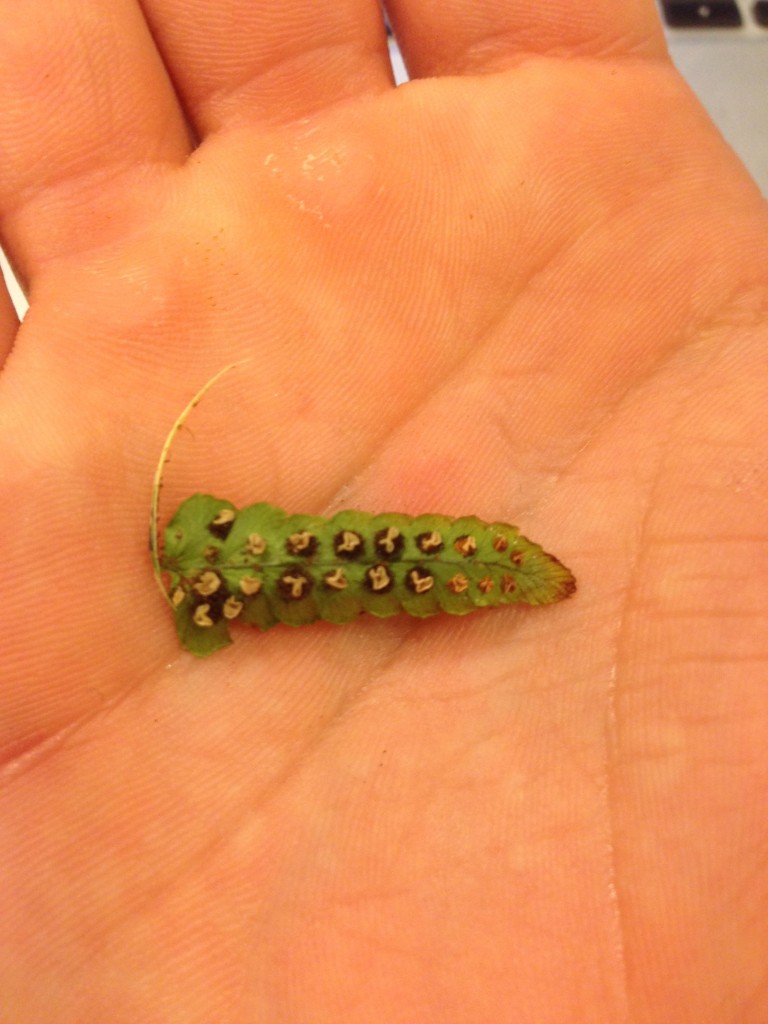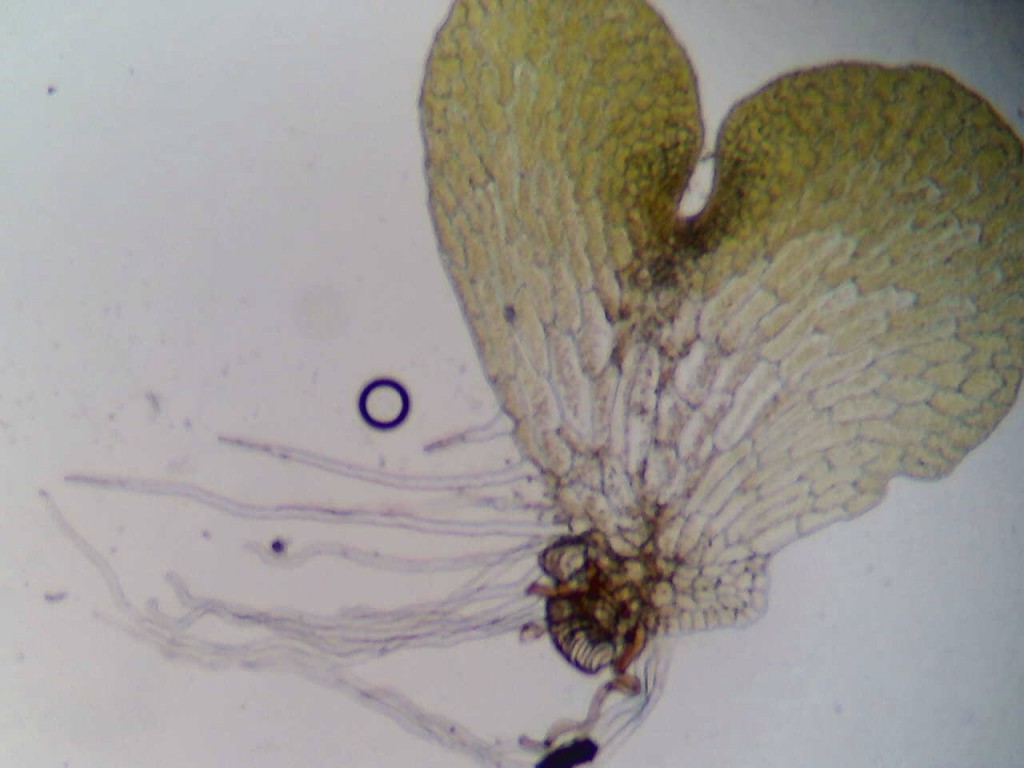The Life of a Fern
When we look out into the spring landscape, we see trees getting their leaves and flowers starting to bloom. These charismatic plants are used for decorating the world around us. We cannot ignore the size of some trees and the size of wooded areas and forests. During the Carboniferous, however, it was the age of the fern (American Fern Society). Ferns were the main land-plant of that era. Today, we tend to find ferns in moist, shady areas alongside the trees of the forest. These forests provide a great deal of protection for the ferns. Not only do ferns depend on a moist environment, woody plants can provide protection from wind, excess sunlight, and excess heat from the sun (AONE 1998).
Even though ferns are typically found in these moist and protected areas, they can survive in many different types of environments ranging from remote mountain areas to dry desert rock faces. Once ferns are growing in a location, they can be very hardy and long-lived. They survive in the crevices of rocks, acidic bogs, and they can be epiphytic on various trees (AONE 1998). Epiphytes are plants that grow harmlessly on other plants, and they are not rooted in soil (Merriam-Websters Dictionary). Ferns and spores can survive the snow, and that explains why we find a variety of species in Ohio. Not every fern can survive all these different types of conditions and many are specialized to a certain ecological niche. A niche is a place or function of an organism within an ecosystem (Dictionary.com). An example of a niche would be the role of a pollinator, like a bee. Pollination is an important role in an ecosystem and is its own niche.





Water Ferns and Fern Diversity. All of the above species are water ferns. There are only three genuses of true water ferns. Some are invasive to Ohio. Water ferns are unique, because they have different sex gametophytes like seed plants, which maybe evidence for the evolution of seed plants. The two pictures at the top display leaves that have trichomes, or hairs on the leaves that direct water off of the leaves so that the fern doesn’t get weighed down by rain water.
Ferns can be used as an indicator of their ecological niche. The association of the plant with soil and the microclimate makes it a good indicator of what conditions are needed for each species of ferns. Ferns can also be used to indicate what type of micro-environments exist within their ecosystem. Surveys for habitat conservation and natural resource management will look at fern abundance and species as indicators for what types of environments are available at the micro-level (AONE 1998).
The Fern Life Cycle, Revisited
Ferns have two main stages of development: the gametophyte stage and the sporophyte stage. The adult, sporophyte plant will release a spore that germinates into the gametophyte stage that participates in sexual reproduction. A gametophyte is a small heart-shaped plant that is only one cell layer thick. Fertilization takes place inside the gametophyte between antheridia (male) and archegonia (female). These structures are found on separate gametophytic plants. Once fertilization has occurred a new sporophyte will sprout up from the gametophyte. In the adult stage, the fern plant starts out as a fiddlehead and then it forms the traditional fern shape. When the adult fern is mature enough it will produce sori and sporangia on the its fronds, or leaves, and then the process starts over again.
 Growing Fiddlehead. A fiddlehead fern is the beginning developmental stage of the sporophyte.
Growing Fiddlehead. A fiddlehead fern is the beginning developmental stage of the sporophyte.
What is known as a “true fern” will sprout out of the ground as a fiddlehead with the fronds unfurling. The term fiddlehead refers to the shape new sporophytes form, which resembles the head of a fiddle. In Ohio, ferns are the most abundant non-seed plant. These ferns are primarily homosporous which means they are produced in globe-like sporangia grouped in sori (Ohio Plants).

Fern Sorus and Sporangia Movement. Close-up of fern sorus with measurement of 3.82mm. Individual sporangium can be seen in both the photo and video. The video highlights how the sporangia can “open and close.”
Ferns begin to produce spores only once they are fully matured. When a fern’s fronds are totally unfurled, the clusters of sporangia, called sori, can begin to form. The sori tend to be on the underside of the fronds in most species of fern. Some species like those in the Adiantum genus, actually have the sori and indusium, the protective covering, along the edge of the fronds. These are called “marginal indusium.” They are often brown in color, and once they mature they darken and lose their protective cover so that spores can be dispersed. These sori that house the sporangia are actively producing spores during the summer in areas like Ohio. In some tropical locations, the sporangia can be active all year long. Ferns are known as homosporous plants since their spores are all roughly the same size and they all perform the same function (UPenn.edu).


Marginal Indusium. Marginal indusium as seen on maiden hair ferns (Adiantum sp.). A younger fern is pictured on the left while an older fern is pictured on the right.

Mature and Immature Indusium. The leaf on the left has the more mature indusium than the leaf on the right, as can be told from the darker color of the protective covering.
Relationships Between Ferns and Other Organisms
Some herbivorous vertebrates eat young fiddlehead ferns in the wild. As the fern grows into an adult, it begins to produce toxins in its fronds that discourage animals from eating them. These toxins are still present in the young ferns, but in lesser amounts. Insects like grasshoppers and snails can eat adult ferns on a regular basis despite the increased toxicity. In the time of the dinosaurs, ferns were actually the main food source for the herbivorous sauropods. Today, many vertebrate animal species that eat ferns only eat certain species at certain times of the year (Walker 2010).
Although some young ferns are safe for animal consumption, there are species like bracken ferns that contain toxins called thiaminase and ptaquiloside. These ferns are eaten as fiddleheads by white-tailed deer and eastern cottontail rabbits with little consequence. Sometimes, when vegetation is scarce, some other animals may resort to eating bracken while others avoid it. Livestock, like swine and horses, can ingest bracken and experience thiaminase-mediated syndrome (Veterinary Public Library 2005). Ptaquiloside has been correlated with esophageal or gastric cancer in humans if it is ingested (Stegelmeier 2014).
Despite their miniscule size, spores can also be a food source for animals. The European woodmouse eats the spores of the European fern Culcita macrocarpa, and it is the only small mammal known to do so. The spores are rich in lipids, and they provide a lot of energy in a very small package. The bullfinch and short-tailed bat are the only other two vertebrates known to feed on the spores of a fern (Walker 2010).
Ferns also have a connection with other organisms. A well-known symbiotic relationship of ferns is with mycorrhizal fungi. This relationship is known as mycorrhizas, meaning “fungus-root,” and it is a mutualistic symbiosis between fungus and root systems of plants. Mutualistic symbiosis means that these two organisms live together and each benefit from the other. The evolution of mycorrhizas is thought to have progressed from an endophytic relationship to the ectophytic relationships that we see today. “Endophytic means tendency to grow inward into tissues in fingerlike projections. Ectophytic means tendency to grow outward beyond the surface ipithelium from which it originates” (Brundrett 2002). During the evolution of this relationship, both partners were independent and over time became interdependent due to the exchange of limiting resources between the two (Brundrett 2002).

Mycorrhizal Relationships. The drawing better illustrates mycorrhizal relationships. The thick black line represents the network of hyphae and the blocks represent the cell wall of the plant.
Primitive ferns like the wisk fern (Psilotum)and the horsetail fern (Equisetum) species have subterranean gametophytes that have Vesicular-Arbuscular Mycorrhizae (VAM) associations. VAM means that fungus grows into the root cells of the host to form two kinds of specialized structures: arbuscules and vesicles (McGraw-Hill Dictionary 2003). The arbuscule is an organ in the fungus that absorbs nutrients and vesicles are structures used for storage. Primitive ferns actually lack arbuscules, but are still considered to have VAM associations. Studies have shown that the majority of complex ferns also have these VAM associations. Most ferns have fine roots with long root hair-like structures, suggesting they have mycorrhizal association that helps with function. Leptosporangiate ferns are considered to be the least dependent on mycorrhizas (Brundrett 2008).
Diversity of Ferns and Their Uses

Linear Sori. The birds nest fern (Asplenium nidus) is part of the family aspleniaceae, in which all members display linear sori. The sori hold the spores and are the brown linear lines in this image.

Specialized Rhizomes. Rabbit’s foot fern (Davallia solida) is known for its thick, fuzzy, rhizomes that creep along the ground or down the side of the pot when placed in a hanging pot.
There are many types of ferns that make up the vast diversity of the taxa such as: bird’s nest fern, boston fern, button fern, rabbit’s foot fern, holly fern, staghorn fern and ostrich fern. They are all unique because of the different ways some of their structures are modified. For example some ferns like the rabbit’s foot fern shown above have modified their rhizomes to creep along the ground whereas some ferns rhizomes are in the ground. The bird’s nest fern, also shown above, has modified linear sori. The different ways the sori are positioned on the leaf is another example of fern diversity.

One Leaf or Many Leaflets? The golden polypody fern (Phlebodium aureum) shows how not all ferns have leaflets. This fern technically doesn’t have leaflets, because the fronds are not separated near the stem, making this all one leaf.
Hokkaido, an island in northern Japan, has approximately the same number of species of ferns as North Eastern America. About 40% of these ferns are considered sister species due to their similar characteristics. Being on opposite sides of the globe it is strange to see species that are so similar without a clear pattern of distribution but such is the case with these ferns. This could be in part due to the similar climates in both regions giving rise to similar evolutionary characteristics (Moran, 2004).
Ferns, unlike some other plants, are not of major economic importance to humans today even though they are a popular horticultural plant. Since they were so prevalent during the Carboniferous Period, the fossils of ancient ferns have actually contributed to the world’s supply of fossil fuels (science.Jrank.org). Our modern ferns still have uses for us today. Many people will grow ferns as ornamental plants and some will search for certain fiddlehead species like the ostrich fern (Matteuccia struthiopteris) for a spring-time treat to put in salads or used as a steamed vegetable.
Tree ferns of the families Dicksoniaceae and Cyatheaceae are also of commercial importance. The trunks of the tree ferns can be used in construction work. The root system of the tree fern also is widely used as a substrate to grow ornamental orchids. Stalks and buds of these ferns can also be made into packing material for pillows and mattresses. This led to the destruction of many populations of tree ferns in tropical locations (Reference.com).
Tree ferns. The first photo on the left is Japanese wood ferns (Dryopteris sieboldii). The middle photo is a Hawaiian tree fern (Cibotium glaucum). The right photo is a giant fern (Angiopteris evecta). Although they are known as tree ferns they are not true trees and the area that looks like a trunk is really just made out of leaf bases.
Different fern species are also used in many Eastern countries as some form of medicine. The study of traditions and uses of plants as medicine in different cultures is known as ethnobotany (Dictionary.com). In the Himalayas, rattlesnake fern (Botrychium virginianum) is turned into a lotion that is spread onto sores, cuts, bruises, and burns. The rhizomes and petioles of the Indian button fern (Tectaria macrodonta) are used in India to relieve constipation (OpenSIU).
Ferns have also been shown to help remove heavy metals, like arsenic, from soil. Arsenic can enter the environment through human activities and is commonly found in pesticide, dyes, and wood preservatives. Arsenic in high doses can be poisonous to people, animals, and many plants (USF.edu). High arsenic levels in soils have become a problem since arsenic-related health problems are increasing all over the world. In 2001, it was discovered that the Chinese brake fern (Pteris vittata) grows well in arsenic-contaminated soil. It accumulates excess arsenic in the fronds and is an environmentally-friendly and cost-effective solution to arsenic-rich soil. Many studies have been done to observe arsenic uptake into the fronds, and the effects that this process may have to other organisms that eat fern fronds (Fayiga et al. 2004).
Why Are Ferns Important?
Ferns have contributed a lot to earth’s natural history. They have provided an important evolutionary stepping stone for land plants as we know them today: vascular tissue. Without plant vascular tissue, we could not have the giant sequoias of California or the orchards of fruit trees that we cultivate. Their fossils have gone on to make important fossil fuels like coal and natural gas. Ferns can also uptake heavy metals from the soil and aid in healing contaminated environments.
Ferns have many uses today that people don’t really think about as well. Some animals use ferns as a source of food. Humans can use ferns as ornaments, or use the tree ferns to help build structures. Even though they are not as charismatic as other vascular plants, they are very interesting and provide us with a glimpse to the past. Hopefully the next time you look at a fern, you will remember everything that they do.
Works Cited:
American Fern Society. (2006). A Brief Introduction to Ferns. Retrieved from: http://amerfernsoc.org/lernfrnl.html
Australian National Botanical Gardens. (1998, July). Ferns as ecological indicators. Retrieved from: http://www.home.aone.net.au/~byzantium/ferns/ecol.html
Australian National Botanical Gardens. (1998, July). About ferns. Retrived from: http://www.home.aone.net.au/~byzantium/ferns/about.html
Brundrett, Mark C. “Coevolution of roots and mycorrhizas of land plants.” New phytologist 154.2 (2002): 275-304.
Brundrett, M. (2008). Mycorrhizal associations: the web resource. Retrieved from: http://mycorrhizas.info/evol.html
Ecological niche. Dictionary.com Unabridged. Retrieved March 29, 2015, from Dictionary.com website: dictionary.reference.com/browse/ecological+niche
Ensminger, PA. (2009). Ferns – importance to humans. Retrieved from: http://science.jrank.org/pages/2689/Ferns-Importance-humans.html
ethnobotany. Dictionary.com Unabridged. Retrieved March 29, 2015 from: dictionary.reference.com/browse/ethnobotany
Fayiga, Abioye O et al. “Effects of heavy metals on growth and arsenic accumulation in the arsenic hyperaccumulator Pteris vittata L.” Environmental pollution 132.2 (2004): 289-296
McGraw-Hill Dictionary of Scientific & Technical Terms, 6E. (2003). Vesicular arbuscular mycorrhizal fungi. Retrieved March 29 2015 from: http://encyclopedia2.thefreedictionary.com/vesicular-arbuscular+mycorrhizal+fungi
Merriam-Webster Dictionary. (2003). Epiphytic. Retrieved from: www.merriam-webster.com/dictionary/epiphytic
Moran, Robin C. (2004). A Natural History of Ferns. Oregon. Timber Press.
Srivastava, Kamini. (2007) “Importance of ferns in human medicine.” Ethnobotanical Leaflets 2007.1: 26.
Stegelmeier, BL. (2014, Feb) Overview of bracken fern poisoning. Retrieved from: http://www.merckmanuals.com/vet/toxicology/bracken_fern_poisoning/overview_of_bracken_fern_poisoning.html#v11577387
The encyclopedic entry of fern. (2008). Retrieved March 30, 2015 from: http://www.reference.com/browse/fern
Veterinary Public Library. (2005). Bracken Fern or Brake Fern (Pteridium aquilinum). Retrieved from: http://www.library.illinois.edu/vex/toxic/bracken/bracken.htm
Walker, M. (2010, Feb 19) A mouse that eats ferns like a dinosaur. Retrieved from: http://news.bbc.co.uk/earth/hi/earth_news/newsid_8523000/8523825.stm








